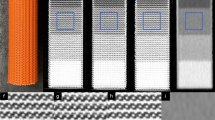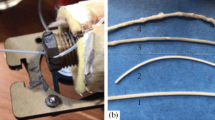Abstract
Three-dimensional (3D) printing technology has been widely used to fabricate customized phantom for patients. High-density structures, such as bone, are not easy to reproduce with regular filaments and require high-density materials. In this study, we use polylactic acid+ (PLA+) filaments and five metal filaments (bronze, copper, aluminum, iron, and tungsten) containing metal powder to investigate variations in the Hounsfield unit (HU) values reflected in computed tomography images under filament and printing output conditions. Samples were produced to verify the element composition using each filament, and scanning electron microscopy–energy dispersive spectroscopy (SEM–EDS) analyses were performed. The variations of HU values according to the infill patterns were verified using PLA+, and six filaments were used to verify the variation in HU values according to the infill rate. SEM–EDS analysis shows that all filaments contain C and O elements in common and account for the largest proportion. In the case of metal filaments, additional elements were observed: Cu (1.77%) in bronze, Na (0.45%) and Al (4.48%) in aluminum, Ca (0.7%) and Fe (2.54%) in iron, and W (1.61%) in tungsten. Linearity was confirmed according to the infill rates using various infill patterns. The results showed high linearity of 0.99 or higher in the determination coefficient (R-squared; R2) of most patterns. However, in the case of the full honeycomb (R2 = 0.8825) and fast honeycomb (R2 = 0.9606) patterns, HU values increased rapidly or gradually at a certain infill rate, indicating a relatively low determination coefficient. The measurement of the variation in HU value according to the type of filament and the degree of filling showed that the higher the degree of filling, regardless of the type of filament, the higher the HU value. For a 100% fill ratio, the average HU value of the cube output to each filament was measured differently at − 28.7, 526.3, 70.1, − 32.3, and 3061 HU for PLA+, bronze, copper, iron, and tungsten, respectively. This study will help express various HU values using 3D printing. Moreover, metal filaments will positively affect reproducing dense anatomical structures, such as bones, which have been difficult to express in previous studies.





Similar content being viewed by others
References
P. Tack, J. Victor, P. Gemmel, L. Annemans, 3D-printing techniques in a medical setting: a systematic literature review. Biomed. Eng. Online 15, 115 (2016). https://doi.org/10.1186/s12938-016-0236-4
Y. Kong, T. Yan, Y. Sun, J. Qian, G. Zhou, S. Cai, Y. Tian, A dosimetric study on the use of 3D-printed customized boluses in photon therapy: a hydrogel and silica gel study. J. Appl. Clin. Med. Phys. 20, 348–355 (2019)
N. Okkalidis, C. Chatzigeorgiou, D. Okkalides, Assessment of 11 available materials with custom three-dimensional-printing patterns for the simulation of muscle, fat, and lung hounsfield units in patient-specific phantoms. J. Eng. Sci. Med. Diagn. Ther. (2018). https://doi.org/10.1115/1.4038228
M.F. Haefner, F.L. Giesel, M. Mattke, D. Rath, M. Wade, J. Kuypers, A. Preuss, H.U. Kauczor, J.P. Schenk, J. Debus, F. Sterzing, R. Unterhinninghofen, 3D-Printed masks as a new approach for immobilization in radiotherapy—a study of positioning accuracy. Oncotarget 9, 6490–6498 (2018). https://doi.org/10.18632/oncotarget.24032
R. Mahmoudi, N. Jabbari, M. Aghdasi, H.R. Khalkhali, Energy dependence of measured CT numbers on substituted materials used for CT number calibration of radiotherapy treatment planning systems. PLoS ONE 11, e0158828 (2016). https://doi.org/10.1371/journal.pone.0158828
R. Tino, A. Yeo, M. Leary, M. Brandt, T. Kron, A systematic review on 3D-printed imaging and dosimetry phantoms in radiation therapy. Technol. Cancer Res. Treat. 18, 1533033819870208 (2019). https://doi.org/10.1177/1533033819870208
J.W. Yea, J.W. Park, S.K. Kim, D.Y. Kim, J.G. Kim, C.Y. Seo, W.H. Jeong, M.Y. Jeong, S.A. Oh, Feasibility of a 3D-printed anthropomorphic patient-specific head phantom for patient-specific quality assurance of intensity-modulated radiotherapy. PLoS ONE 12, e0181560 (2017). https://doi.org/10.1371/journal.pone.0181560
M.J. Kim, S.R. Lee, M.Y. Lee, J.W. Sohn, H.G. Yun, J.Y. Choi, S.W. Jeon, T.S. Suh, Characterization of 3D printing techniques: toward patient specific quality assurance spine-shaped phantom for stereotactic body radiation therapy. PLoS ONE 12, e0176227 (2017). https://doi.org/10.1371/journal.pone.0176227
Z. Lu, O.I. Ayeni, X. Yang, H.-Y. Park, Y.-G. Jung, J. Zhang, Microstructure and phase analysis of 3D-printed components using bronze metal filament. J. Mater. Eng. Perform. 29, 1650–1656 (2020). https://doi.org/10.1007/s11665-020-04697-x
M. Alssabbagh, A.A. Tajuddin, Evaluation of nine 3D printing materials as tissue equivalent materials in terms of mass attenuation coefficient and mass density. Int. J. Adv. Appl. Sci. 4, 168–173 (2017)
J. Madamesila, P. McGeachy, J.E.V. Villarreal Barajas, R. Khan, Characterizing 3D printing in the fabrication of variable density phantoms for quality assurance of radiotherapy. Phys. Med. 32, 242–247 (2016). https://doi.org/10.1016/j.ejmp.2015.09.013
T. Kamomae, H. Shimizu, T. Nakaya, K. Okudaira, T. Aoyama, H. Oguchi, M. Komori, M. Kawamura, K. Ohtakara, H. Monzen, Y. Itoh, S. Naganawa, Three-dimensional printer-generated patient-specific phantom for artificial in vivo dosimetry in radiotherapy quality assurance. Phys. Med. 44, 205–211 (2017). https://doi.org/10.1016/j.ejmp.2017.10.005
S.-Y. Park, N. Choi, B.G. Choi, D.M. Lee, N.Y. Jang, Radiological characteristics of materials used in 3-dimensional printing with various infill densities. Prog. Med. Phys. 30, 155–159 (2019). https://doi.org/10.14316/pmp.2019.30.4.155
N. Kadoya, K. Abe, H. Nemoto, K. Sato, Y. Ieko, K. Ito, S. Dobashi, K. Takeda, K. Jingu, Evaluation of a 3D-printed heterogeneous anthropomorphic head and neck phantom for patient-specific quality assurance in intensity-modulated radiation therapy. Radiol. Phys. Technol. 12, 351–356 (2019). https://doi.org/10.1007/s12194-019-00527-5
S. Matheus, M. Andrade, M. Potiens, Commercial filament testing for use in 3d printed phantoms. Radiat. Phys. Chem. 174, 108906 (2020). https://doi.org/10.1016/j.radphyschem.2020.108906
N. Okkalidis, C. Chatzigeorgiou, D. Okkalides, Assessment of 11 available materials with custom three-dimensional-printing patterns for the simulation of muscle, fat, and lung hounsfield units in patient-specific phantoms. J. Eng. Sci. Med. Diagn. Ther. 1, 7 (2017). https://doi.org/10.1115/1.4038228
Author information
Authors and Affiliations
Corresponding author
Additional information
Publisher's Note
Springer Nature remains neutral with regard to jurisdictional claims in published maps and institutional affiliations.
Rights and permissions
Springer Nature or its licensor holds exclusive rights to this article under a publishing agreement with the author(s) or other rightsholder(s); author self-archiving of the accepted manuscript version of this article is solely governed by the terms of such publishing agreement and applicable law.
About this article
Cite this article
Kim, T., Kim, J. & Kim, E. Study on the radiological characteristics of metal infilled filaments for three-dimensional printing according to the infill rate and pattern. J. Korean Phys. Soc. 81, 1174–1181 (2022). https://doi.org/10.1007/s40042-022-00593-w
Received:
Revised:
Accepted:
Published:
Issue Date:
DOI: https://doi.org/10.1007/s40042-022-00593-w




